Bold Ways to Change Your Meetings
PREMEETING AND AGENDA PRACTICES
Don’t over invite. The quality of meetings plummets as the number of attendees goes up. Keep meetings as lean as possible. As meetings expand in size, dysfunction also expands. Try the questions vs. topics approach below to minimize attendance.
Questions vs. topics. Think about each item on the agenda as a question to be answered. Framing items as questions gives you a better sense of who should be invited—only those relevant to the questions. If you can’t generate a question, remove that item from the agenda entirely. End the meeting when questions have been answered.
Set meeting expectations. Develop meeting expectations by talking with attendees in advance about what makes for a good meeting, from their perspective.
Don’t fly solo when planning the agenda. The leader should not be the only one contributing to the meeting’s agenda. Ideas for the agenda can also come from the attendees themselves.
Remember Parkinson’s law. According to Parkinson’s law, work expands to fill whatever time is allotted for it. If a meeting is scheduled for one hour, it will automatically expand to one hour. Try a 30-minute meeting and you’ll have increased focus and a sense of urgency to finish within the allotted time.
Answer critical questions first. Early agenda items receive a disproportionate amount of time and attention, so make sure your most critical questions come first.
Assign owners. Each agenda item can be “owned” by a different person to help make the meeting more inclusive. This person should facilitate the discussion around the item.
DURING-MEETING PRACTICES
Create good beginnings. Because you are the leader, your mood sets the tone. Research suggests it produces a ripple effect: attendees’ moods will mirror your mood. Walk in with a positive attitude.
Brainstorm in silence. Research supports the benefits of silent brainstorming in meetings as a way to gather better ideas, perspectives, and insights. Brainstorm via writing—everyone can do it simultaneously, no one needs to wait for their turn, and there is less filtering and critiquing, given the simultaneous generation of ideas.
Facilitate, facilitate, and facilitate. Your job as a meeting leader is facilitation. Be sure voices are heard and meaningful discussion occurs.
Postmeeting Practices End on time. Meetings that run late are a tremendous source of stress for individuals, as attendees have planned their next time for something other than a late-running meeting.
Assign DRIs. Apple introduced us to the term DRI (directly responsible individual): the one person who will be held accountable for the project or next steps. For any action items, there should be an assigned DRI.
Source: Steven Rogelberg, PhD author of The Surprising Science of Meetings
Looking for more print and marketing tips? Check out the Inspired Momentum archive.

